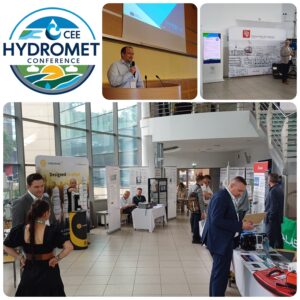The second webinar in the D-HYDROFLEX series, titled “Operation and Maintenance”, was held on Tuesday, 27 May 2025. This session explored how digital tools and predictive technologies are being used to improve the efficiency, reliability, and flexibility of hydropower systems through practical examples and cutting-edge research.
The first presentation, delivered by Przemysław Janik from TAURON Ekoenergia and Artur Machalski from Wrocław University of Science and Technology, focused on the implementation of digital twins for plant operation under the D-HYDROFLEX project. One of the key tools discussed was HYDRO-TIN, a system for assessing turbine efficiency by analyzing data such as flow rate, water levels, rotational speed, and blade angles. HYDRO-TIN generates efficiency curves and compares real measurements with model predictions to optimize turbine performance. It is currently being implemented at the Wały Śląskie run-of-river hydropower plant, which has four Kaplan turbines and an installed capacity of 9.8 MW.
Another tool in development is HYDRO-MAP, a digital model of the turbine that uses a four-stage approach combining gauge data and LSTM neural networks to forecast water flow. This enables proactive operational planning and resource management. Additionally, HYDRO-PVIL provides a multi-level approach to vibration monitoring, starting with basic threshold alerts and advancing toward predictive maintenance capabilities. One of the major challenges highlighted was the outdated and inconsistent measurement equipment at the plant, which led to a review and planned upgrade of the monitoring infrastructure to ensure the availability of accurate and complete operational data.
The second presentation was given by Weiwei Chen from the University of London and Alwyn Mathew from the University of Cambridge. They focused on developing a digital twin of a dam structure to support infrastructure management. First part of their presentation addressed the value of a geometric digital twin, which allows for accurate 3D modeling of dam structures to improve inspection, maintenance planning, and risk assessment. This digital approach supports all stages of the dam lifecycle—from design and construction to operation and renovation.
However, they also identified several challenges: a lack of open-source data, particularly for dam interiors and hydroelectric components; difficulties scanning upstream dam faces due to submersion; and the architectural diversity of dams, which complicates model generalization. During the second part of the presentation, the development of a data model and digital twin platform were discussed. Here, the balance between model complexity and real-time performance was a key issue, as was the need for high-quality sensor data. Real-time processing of large volumes of sensor data requires robust computational and network resources. Presenters outlined implementation scenarios such as real-time water flow and resource management, monitoring of hydropower-specific equipment, and emergency response systems using various environmental and structural sensors.
The final presentation was given by Israel Ohiemi from Trinity College Dublin as part of the iAMP-Hydro project. He presented an overview of how predictive maintenance systems are being developed using sensors, CFD (Computational Fluid Dynamics), and AI. At the heart of this system is the Intelligent Data Management Layer (iDML), which handles data collection and storage, and employs machine learning and deep learning models. This is complemented by the Intelligent Data-driven Optimisation Layer (iDOL), which integrates data outputs with external inputs such as energy market data and renewable energy sources to enhance hydropower operation and maintenance.
He also discussed common failure mechanisms in hydro turbines and how predictive modeling can be used to estimate the time-to-failure. One of the primary challenges is the lack of comprehensive design drawings for older plants, along with physical deterioration and modifications over time. These issues make it difficult to create accurate geometric models, especially in areas with restricted access.
The session concluded with a Q&A, where attendees raised important questions about the severity of missing turbine documentation and how extreme events like flash floods or earthquakes can be modeled.
💡 Key Takeaways💡This webinar highlighted the transformative role of digital innovation in hydropower operations. With digital twins, AI-based monitoring, and predictive maintenance strategies becoming increasingly central, the hydropower industry is better equipped to manage assets, reduce downtime, and optimize performance even in the face of aging infrastructure and complex environmental challenges.
Stay tuned for more insights in the upcoming D-HYDROFLEX webinars as we continue to explore the digital future of sustainable hydropower.
If you missed our webinar, you can watch the recording here for more details.
Stay updated on upcoming events and project developments by visiting our website and following us on social media on LinkedIn and X!



